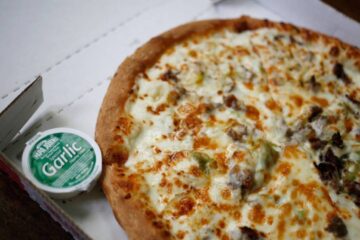It was the summer of 1999.
My mom had just dropped me off at day camp at the local JCC. The sun was already beating down, and the blacktop outside the gymnasium shimmered with heat.
I had my Lisa Frank notebook, an extra scrunchie around my wrist, and a lunchbox filled with what I looked forward to all morning: a mini-hot dog Lunchables, a packet of Dunkaroos, and a Capri Sun.
After carefully stabbing the straw through the foil pouch, I’d suck it down like I had been stranded in the desert.
Related: Target struggles to stop spiral amid customer backlash
Then I’d fold the empty Capri Sun into a rectangle and pretend it was a flip phone, wedging it between my shoulder and ear as I strutted around the picnic table like I was deep in conversation.
To five-year-old me, this was peak cool. Those lunches weren’t just meals…they were mini moments of freedom.
Paired with afternoons of water games, tie-dye shirts, and making friendship bracelets, that summer felt like magic.
I hadn’t thought about that version of summer in a long time. But now, one company is bringing it all back.
Time to dust off the jelly sandals — and maybe the old Capri Sun flip phone, too.
Instacart rolls out savings with a ’90s nostalgia twist.
Instacart taps nostalgia to boost business
Instacart’s new national campaign, “Summer Like It’s 1999,” is more than a clever ad play. It’s a data-backed move aimed at drawing in Millennial shoppers who are balancing inflation with a craving for simpler times.
According to a Harris Poll survey commissioned by Instacart, 79% of Americans who grew up in the ’90s say they often reflect on their childhood summers.
That insight inspired the platform not only to embrace the vibe of the decade (with commercials full of butterfly clips, water guns, and baggy jeans) but also to slash prices on grocery items that defined it.
Related: Lululemon’s latest viral product reveals something much bigger
Through September 5, shoppers can get up to 47.2% off classic summer snacks like Capri Sun, Bagel Bites, Otter Pops, Kool-Aid, and more.
That discount isn’t arbitrary. It’s based on the CPI change between 1999 and now, a nod to the real economic pressures families are facing.
The idea is clear: if you’re going to take shoppers on a trip down memory lane, make it affordable.
How Instacart’s nostalgia play supports its growth strategy
In Q1 2025, Instacart saw orders rise 14% year-over-year to 83.2 million. Revenue also climbed 9% to $897 million. Company’s CEO Fidji Simo said the brand is doubling down on what matters most to customers: “convenience, affordability, quality, and selection.”
Instacart has made it clear it wants to be more than a utility. The brand is now betting big on emotional connection — leaning into joy, simplicity, and the power of shared memories to deepen loyalty.
And the business case is there, too. Advertising revenue climbed 14% year-over-year, driven by brands investing more heavily in Instacart’s growing media network. By leaning into campaign storytelling, the platform is positioning itself as a compelling space for high-intent advertising, not just grocery logistics.
More on retail:
Beloved discount grocery chain has massive US plansTrader Joe’s rival launches wine battle with new private labelKroger announces big store change amid price gouging accusations
The ’90s campaign also supports another Instacart focus: increasing value perception. With grocery inflation still top of mind, even a small discount on nostalgic brands can feel like a meaningful win.
By combining AI-driven personalization, smart pairing tools, and strategic partnerships with Chase and United, Instacart is working to turn occasional shoppers into loyal, repeat customers.
The summer push is a blend of emotional resonance and strategic timing. It tells shoppers: “We get it…life’s expensive. But it can still be fun.”
Whether this nostalgia-fueled play creates long-term growth remains to be seen. But for now, it’s kicking off summer with a smile.
Related: Post Malone makes deal with Stanley for signature cup


